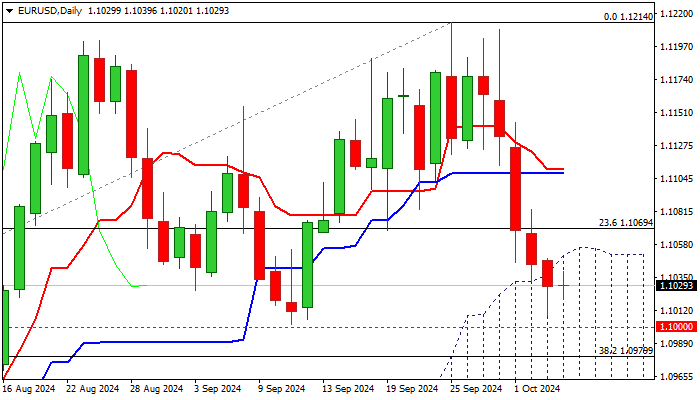EUR/USD Bears Maintain Control, Pressuring Key 1.10 Support Zone Ahead of US Labor Data*
EUR/USD continues to trade firmly lower on Friday, hovering near its lowest levels in almost a month. Bears are targeting the critical 1.10 support zone, which includes the psychological level, the September 11 higher low, and the 38.2% Fibonacci retracement of the 1.0601/1.1204 uptrend. A break below this zone would trigger a reversal signal, confirming the breach of the multi-week consolidation range and completing a double-top pattern on the daily chart.
The pair has already broken through the initial Fibonacci support at 1.1069 (23.6%) and is now trading within the thick ascending daily Ichimoku cloud (spanning between 1.1056 and 1.0933). A weekly close within the cloud would reinforce the negative outlook for EUR/USD.
Technical signals show rising downside momentum, with the 10/20-day moving averages converging in a bearish setup and on the verge of forming a bear cross. However, oversold conditions and anticipated resistance from the thick Ichimoku cloud and the strong 1.10 support zone could provide some relief to the downside pressure.
We await firmer signals, either through a sustained break below the 1.10 zone or a bounce and close above the cloud top. A rally through the converged daily Tenkan/Kijun-sen levels (1.1111/08) would ease the immediate bearish pressure and suggest further bullish potential.
Fundamentals are weighing against the euro. The ECB has garnered more support for potential rate cuts after Eurozone inflation dropped below the 2% target. Additionally, the EU composite PMI fell below 50 in September, signaling contraction in the region’s economy.
Attention now turns to the release of US labor data for September. Nonfarm payrolls are expected to rise modestly (147K forecast vs. 142K in August), with average earnings projected to ease (0.3% m/m forecast vs. 0.4% in August) and unemployment expected to hold steady at 4.2%.
If US hiring falls below expectations, particularly below the 100K mark, it could indicate a cooling labor market and increase the likelihood of another sizable Fed rate cut next month, potentially supporting the euro. Conversely, stronger-than-expected NFP data would bolster the dollar and increase pressure on the euro.
Res: 1.1056; 1.1069; 1.1110; 1.1144
Sup: 1.1000; 1.0980; 1.0930; 1.0907


